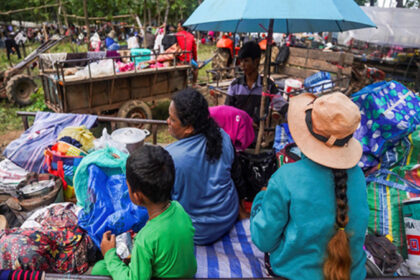Operation Sindoor: Concerns Over Transparency and Tech Risks in India-US Defence Ties
United States Air Force (USAF) combat veteran, the retired Lieutenant general David A. Deptula, who is a leading authority on modern air power, has said that he believes that the Indian Air Force lost at least two fighter jets on the first night of Operation Sindoor, one of them widely believed to be a Rafale.
Deptula is a leading architect of modern airpower, with a 34-year USAF career. He planned the “Desert Storm” air campaign, led the initial post-9/11 “Operation Enduring Freedom” in Afghanistan, and logged over 3,000 flying hours, including 400 in combat.
As the Air Force’s first Deputy Chief of Staff for Intelligence, Surveillance, and Reconnaissance (ISR), he transformed drone and intelligence operations and authored the pivotal ‘Global Reach – Global Power’ doctrine. Now dean of the Mitchell Institute, he advises global defence efforts, including Ukraine’s air strategy. Widely published and honoured for lifetime contributions, Deptula remains a key voice in shaping air and space power.
Citing independent satellite imagery, open-source intelligence, and credible media reports, Deptula said visual evidence from Kupwara and Poonch matched the wreckage of Rafale and MiG-29 aircraft. He noted that the IAF operated under strict political constraints to avoid crossing escalation thresholds that could provoke broader conflict, including the nuclear kind.
Deptula criticised India’s fragmented military command structure and contrasted it with Pakistan’s leaner, rapidly modernising forces supported by Chinese arms – over 80% of its weapons imports coming from China. He also pointed to chronic delays in India’s indigenous aerospace projects, slow procurement processes, and budgetary issues, all of which hamper the IAF’s ability to meet squadron strength.
Deptula says that India must move away from its reliance on aging Soviet-era aircraft and its overstretched supply chains. The following are edited excerpts from the interview.
What do you believe happened on the first night of Operation Sindoor?
The first night of Operation Sindoor was marked by intense aerial engagements. The Indian Air Force (IAF) launched deep penetration strikes against militant infrastructure across the Line of Control, triggering a swift response from Pakistan. Both sides scrambled fighters, leading to a highly dynamic, contested air environment. It became clear early that both nations were operating under tight political constraints to avoid escalation into full-scale war, but the tempo of operations was high. Multiple external and credible sources do support the assessment that the Indian Air Force (IAF) sustained significant combat losses on the first night of the operation despite achieving strategic surprise.
Was the Indian Air Force constrained by non-escalatory rules of engagement?
Yes, very much so. India imposed strict political limits to avoid crossing escalation thresholds that could have provoked a broader conventional or even nuclear conflict. The IAF had to balance tactical effectiveness with strategic restraint—often sacrificing operational opportunities in favour of political signalling and de-escalation.

Do you believe the IAF suffer losses, and what tactical lessons emerged?
Independent satellite imagery, open-source intelligence, and reporting by reputable outlets confirm the loss of at least two Indian fighters—one of which is widely assessed to have been a Rafale. Visual analysis of wreckage near Kupwara and Poonch aligns with the structure and configuration of Rafale and MiG-29 aircraft. Additionally, several think tanks have each published analytical summaries corroborating the loss of multiple IAF aircraft, including a Rafale, a MiG-29, and likely a Su-30MKI. US officials have been cited as confirming with high confidence that Pakistani J-10Cs employing PL-15 missiles were responsible for at least two of those kills.
These external assessments paint a clearer picture than Indian officialdom has publicly offered. They also reinforce the urgency of the tactical lessons: the IAF encountered a level of air defence integration – fuelled by Chinese sensors and long-range missiles – that it was not fully prepared to counter. The evidence demands a re-evaluation of India’s existing capabilities in contested airspace, and its ability to fight in sensor-dense battlespace. So yes – while official disclosures remain limited, the external, independent assessments leave little doubt that the IAF suffered multiple aircraft losses, including likely a Rafale, and those losses underscore serious tactical and operational lessons moving forward.
How significant were the constraints of not having Rafale source code access?
Critically significant. The source code governs crucial aspects of the Rafale, including its radar, targeting systems, and electronic warfare capabilities. Without access, India is reliant on French cooperation for upgrades and modifications. As a result, the IAF was unable to rapidly reprogram the Rafale for indigenous munitions or optimise data-link interoperability with Indian and allied systems. This restricts operational flexibility, delays decision-making processes, and reduces the benefits of deploying an advanced fighter in an environment dominated by previous generation aircraft.
What do you believe turned the tide after the setbacks of May 7?
The turnaround stemmed from the employment of longer-range stand-off weapons and improved electronic warfare packages. Air-launched cruise missiles and extended-range air-to-air missiles allowed Indian aircraft to strike without entering dense threat envelopes. Operational adaptation, coupled with satellite-fed targeting, rebalanced the tactical situation in India’s favor.
How do you believe Chinese tech and support shape Pakistan’s performance?
China’s support provided Pakistan with advanced weaponry, intelligence, and a degree of operational coordination. However, the conflict also highlighted potential limitations of certain Chinese systems and raised questions about the overall effectiveness of Pakistan’s military efforts despite this backing. Reports indicate that some Chinese weapons systems, such as the PL-15E missile, did not perform well. Pakistan suffered significant losses of aircraft and air defence systems supplied by China, raising questions about their reliability in combat.
What do you think are the IAF’s critical capability gaps?
The Indian Air Force (IAF) currently grapples with an aging fleet of legacy aircraft such as the MiG-29 and Mirage 2000, while lacking any operational stealth aircraft. Compounding this challenge is the historically fragmented nature of India’s military command structure. With separate, service-specific commands for the Army, Navy, and Air Force, coordination has often been hampered, leading to delayed responses during crises, reduced interoperability among branches, and inefficient allocation of resources.
Meanwhile, Pakistan’s military maintains a leaner but increasingly modernised force, largely supported by China, from whom it sources over 80 percent of its imported weapons. India’s indigenous aerospace sector continues to face chronic delays in both the development and production of domestic weapon systems. Former Air Chief Marshal Vivek Ram Chaudhari once pointed out that not a single indigenous project has met its deadline. These prolonged delays, along with a sluggish procurement process and persistent budget limitations, significantly hinder the IAF’s capacity to expand its fleet and fill critical squadron shortfalls.
How important is transparency during conflict?
Strategic transparency shapes international perception and deterrence credibility. Therefore, it is very important but a debated aspect surrounding Operation Sindoor, with sources highlighting both the need for, and perceived shortcomings, in transparency during and after the operation. While India emphasised fact-based communication and dedicated significant time to countering disinformation during Operation Sindoor, the operation also sparked critical discussions about the need for greater transparency regarding operational losses, communication strategies, and information control. Strategic messaging must be fully complemented with military actions to effectively manage the information war.
Was the Trump ceasefire linked to limiting Chinese exposure?
While there are arguments suggesting that the President Trump ceasefire in the Indo-Pak conflict was linked to limiting Chinese exposure, this was likely one of several factors at play. President Trump’s stated focus was on mediation and trade, and India’s position emphasised direct negotiations with Pakistan. Ultimately, the complex geopolitical dynamics and varying perspectives make it difficult to definitively attribute the ceasefire solely to limiting Chinese exposure.
Does the competition over source code reflect strategic pressures?
Absolutely. Source code is the new sovereign edge in fighter jet diplomacy. The US and France guard their intellectual property to protect integration security and geopolitical leverage. Russia, facing economic isolation, offers source code as a bargaining chip to attract clients. This reflects both strategic desperation and a broader power-tech competition in the global defence market.
How will future India-Pakistan air battles evolve?
The dominant factor in a future India-Pakistan or any peer-level air war will be the ability to penetrate, persist, and strike in denied environments – and that requires stealth. India’s plans for the AMCA, and possible interest in the F-35, reflect this recognition. In contrast, Pakistan remains reliant on fourth-generation aircraft like the JF-17. Chinese semi-stealth fighters such as the J-20 remain operationally unproven and may be technologically limited by engine performance and systems integration.
Why is the US re-engaging with Pakistan?
The US is re-engaging with Pakistan to preserve strategic leverage in a region increasingly influenced by China. By maintaining ties, Washington seeks to dilute Beijing’s grip, manage escalation risks between India and Pakistan after Operation Sindoor, and retain intelligence access for counterterrorism operations in the Afghanistan-Pakistan corridor. Re-engagement also prevents a strategic vacuum that Russia could exploit, while subtly signalling to India that deeper ties with Moscow come with diplomatic costs. This is not a return to alliance, but a pragmatic effort to retain options, manage crises, and shape regional dynamics without ceding ground to rivals.
How does China compare to the US in advanced military technology?
China is closing the gap with the US in several key domains – but it still lags in true operational integration, combat-tested aircraft, and global power projection. China leads in specific areas such as hypersonic glide vehicles, missile range density in the Indo-Pacific, and civil-military fusion that accelerates AI and quantum experimentation. However, the U.S. retains clear superiority in stealth aircraft (e.g., F-35, B-21), undersea warfare, large-scale joint operations, and resilient space architecture. Crucially, American technologies are battle-hardened, globally networked, and supported by a deep alliance system – something China lacks. In essence, China is innovating aggressively in asymmetric and regional-denial capabilities, but the US still holds the edge in high-end, multi-domain war-fighting and global reach.
How do you think these trends shape the Pacific battlespace?
Future Pacific conflicts will centre on distributed, stealth-enabled, and network-resilient operations, with survivability and tempo taking precedence over mass. Penetrating stealth, agile basing, undersea warfare, and space resilience will be critical. China will aim to strike first, blind U.S. forces through jamming and anti-satellite weapons, and deny entry to key chokepoints like the first island chain. The U.S. response will hinge on rapid, integrated kill webs linking F-35s, B-21s, submarines, and space assets to maintain initiative in a fragmented but fluid battlespace. In short, the Pacific is becoming a battlespace of precision, stealth, and persistence—where the side that can sense, decide, and strike faster across domains will prevail.
Also Read: JP Nadda Flags Off Ayushman Bharat Registration Vans and Distributes Appointment Letters in Delhi








